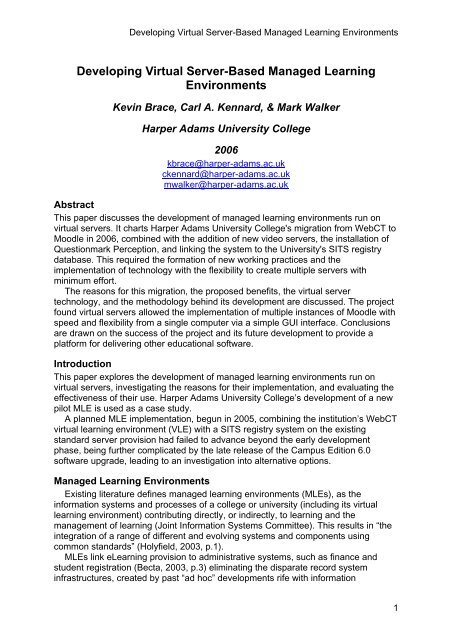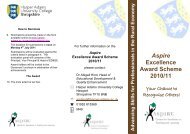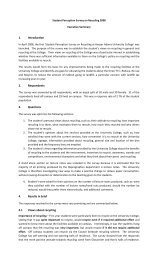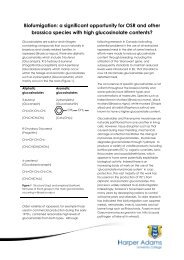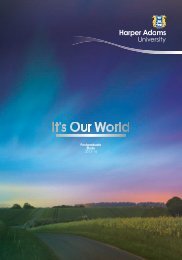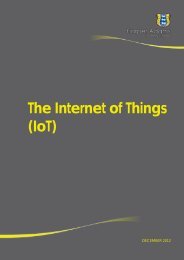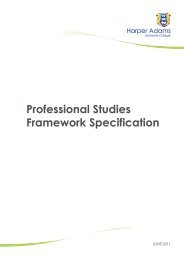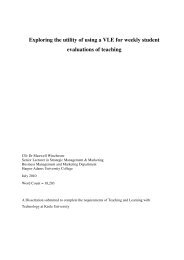Developing Virtual Server-Based Managed Learning Environments
Developing Virtual Server-Based Managed Learning Environments
Developing Virtual Server-Based Managed Learning Environments
You also want an ePaper? Increase the reach of your titles
YUMPU automatically turns print PDFs into web optimized ePapers that Google loves.
<strong>Developing</strong> <strong>Virtual</strong> <strong>Server</strong>-<strong>Based</strong> <strong>Managed</strong> <strong>Learning</strong> <strong>Environments</strong><strong>Developing</strong> <strong>Virtual</strong> <strong>Server</strong>-<strong>Based</strong> <strong>Managed</strong> <strong>Learning</strong><strong>Environments</strong>Kevin Brace, Carl A. Kennard, & Mark WalkerHarper Adams University College2006kbrace@harper-adams.ac.ukckennard@harper-adams.ac.ukmwalker@harper-adams.ac.ukAbstractThis paper discusses the development of managed learning environments run onvirtual servers. It charts Harper Adams University College's migration from WebCT toMoodle in 2006, combined with the addition of new video servers, the installation ofQuestionmark Perception, and linking the system to the University's SITS registrydatabase. This required the formation of new working practices and theimplementation of technology with the flexibility to create multiple servers withminimum effort.The reasons for this migration, the proposed benefits, the virtual servertechnology, and the methodology behind its development are discussed. The projectfound virtual servers allowed the implementation of multiple instances of Moodle withspeed and flexibility from a single computer via a simple GUI interface. Conclusionsare drawn on the success of the project and its future development to provide aplatform for delivering other educational software.IntroductionThis paper explores the development of managed learning environments run onvirtual servers, investigating the reasons for their implementation, and evaluating theeffectiveness of their use. Harper Adams University College’s development of a newpilot MLE is used as a case study.A planned MLE implementation, begun in 2005, combining the institution’s WebCTvirtual learning environment (VLE) with a SITS registry system on the existingstandard server provision had failed to advance beyond the early developmentphase, being further complicated by the late release of the Campus Edition 6.0software upgrade, leading to an investigation into alternative options.<strong>Managed</strong> <strong>Learning</strong> <strong>Environments</strong>Existing literature defines managed learning environments (MLEs), as theinformation systems and processes of a college or university (including its virtuallearning environment) contributing directly, or indirectly, to learning and themanagement of learning (Joint Information Systems Committee). This results in “theintegration of a range of different and evolving systems and components usingcommon standards” (Holyfield, 2003, p.1).MLEs link e<strong>Learning</strong> provision to administrative systems, such as finance andstudent registration (Becta, 2003, p.3) eliminating the disparate record systeminfrastructures, created by past “ad hoc” developments rife with information1
<strong>Developing</strong> <strong>Virtual</strong> <strong>Server</strong>-<strong>Based</strong> <strong>Managed</strong> <strong>Learning</strong> <strong>Environments</strong>replication (Allison, Bain, Ling, & Nicoll). This allows an institution’s VLE to “join up”(Conole, 2002, p.6) with other systems, such as:• Administrative course information• Resources• Student support• Collaboration tools• Assessment and feedback• Evaluation (Conole, 2002, p.6)Although MLEs can provide integrated infrastructures, existing literature maintainsthey should not be viewed as an all encompassing solution, being incapable ofmeeting all of a user’s needs (Conole, 2002, p.10).<strong>Virtual</strong> <strong>Learning</strong> <strong>Environments</strong>VLEs enable online interaction between teachers and students while makinglearning objects, course materials, and assessment tools available via the WorldWide Web, (Becta, 2003, p.1) being central to MLE construction. These systems arewidely applied in Higher Education, often providing access to distance learningcourses (Becta, 2003, p.3).Asynchronous learner communication via discussion groups and message boardsis an important VLE attribute, enabling students to learn from their peers, (Alessi &Trollip, 2001, p.34) potentially increasing learner motivation, (Becta ICT Research)and giving learners the opportunity to reflect on their work (Nulden & Hardless).Reflection allows students to see how solutions can be used a “tools” (Papert, 1980,p.76) applicable to a number of different contexts.Critics of asynchronous communication believe it can leave the learner with arestricted view of wider course contexts, while the lack of face-to-face contact leadsto lower attendance rates (Nulden & Hardless). Other authors suggest a combinationof well designed activities and providing feedback via synchronous andasynchronous communication tools will help to emulate the traditional face-to-faceinteraction promoted by the conversational model (Laurillard, 1993).VLEs transform the teacher’s role from sage-on-the-stage behaviourist instructorto constructivist guide-by-the-side (Druin & Solomon, 1996, p.16). Constructivistsbelieve people learn based on prior knowledge (Nulden & Hardless). Theconstructivist lead learner begins to develop related concepts and take greatercontrol of their own learning (Christie, James, Vaughn, 1996), adopting greaterownership of the varied VLE resources (Haung, 2002). The teacher’s responsibility isto deduce and “capitalise” (Druin & Solomon, 1996, p.16) on learners’ personaleducational strategies, (Druin & Solomon, 1996, p.16) offering negotiated pathwaysand increased autonomy, whilst providing support materials (Papert, 1980, p.31-32.).The promotion of learner autonomy can be further improved by incorporating a widerange of engaging resources and support mechanisms (Phillips, 1996) (often linkedto the WWW) helping to guide the learning experience (Laurillard, 1993).By assuming a manager role, teachers encourage learners to “look critically attheir own work” (Schneider, Syneta, Fete, Giradin, & Morand, 2003) and discuss theirprogress with their peers. Functioning as an advisory facilitator, teachers providesupport materials, enabling learner progression and offering help when obstaclesbecome impossible to independently overcome (Schneider et al., 2003). Teachersinitially employ “scaffolding,” techniques (Nulden & Hardless) to offer the learner“contextual support,” (Boyle) then gradually withdraw materials and assistance asstudents become more independent (Boyle). The supportive tiered framework2
<strong>Developing</strong> <strong>Virtual</strong> <strong>Server</strong>-<strong>Based</strong> <strong>Managed</strong> <strong>Learning</strong> <strong>Environments</strong>provided by the learning facilitator and VLE is best described by the five stage model(Salmon, 2002). Learners given an assignment without scaffolding provision maystruggle during the early stages, stray off-task, or produce inadequate work(Schneider et al., 2003).Teachers should avoid overloading learners with extensive systems, striking abalance between a variety of engaging tools, and pedagogies (Schneider et al.,2003) in an easily used environment they will be able to use effectively (Misrah,2002). It is the learners who create a thriving community, not computer systems(Strohecker, 1994) and even the most technically advanced VLE can fail without theirparticipation.MethodThe development of Harper Adams University College’s new MLE had five primaryobjectives:• Develop a sustainable platform for the eventual migration of all the college’sexisting courses to a new VLE.• Integrate the VLE with the college’s registry system, to ensure centralisation ofuser data.• Incorporate the TALIS list reading list software.• Link the VLE with a learner centric portal, replacing the current intranet.• Develop a scalable system with the scope for the future addition of further E-<strong>Learning</strong> tools.Moodle MigrationFollowing research into usability and system integration options, Moodle waschosen as the replacement for WebCT. Moodle is a SCORM compatible (Galmacci &Milito, 2005, p.4) course-management style VLE created by Martin Dougiamas,(Brandl, 2005, p.1) with roots in socio-constructivist pedagogy (Technical AdvisoryService for Images, 2005, p.1). It contains both synchronous and asynchronouscommunication tools to encourage collaborative learning and the development of“communities of practice,” (Dougiamas & Taylor, p.2) providing an alternative toincreasingly expensive commercial software (Brandl, 2005, p.1). Moodle (ModularObject-Orientated Dynamic <strong>Learning</strong> Environment) is a free open source productwhich can be downloaded from the Internet, enabling financial costs to be reduced.Using open source software provides independence from commercial providers, thefull, customisable source code being available to the wider community, (Ratschiller,2000) allowing individual institutions to adapt software to their personal requirements(Cooke, 1999).Moodle is able to act as scaffolding for classroom instruction, a blended learningcourse component, or a platform for online distance education (Brandl, 2005, p.2).The system is comprised of a number of activity modules to aid the lecturer, includingchat rooms, discussion forums, wikis, assignments, multiple choice quizzes, andsurveys (Galmacci & Milito, 2005, p.4). The modular structure of Moodle uses a “flatview format” (Brandl, 2005, p.2) organising the various screen elements into easilynavigable blocks. The intuitive look and feel of the Moodle GUI compared to WebCTwas a deciding factor in its initial selection. Moodle offered a traditional website feel,ensuring user affordances (Norman, 1988) of existing GUI's were maximised for theVLE, making the new system easier to learn (Neilsen, 1993).3
<strong>Developing</strong> <strong>Virtual</strong> <strong>Server</strong>-<strong>Based</strong> <strong>Managed</strong> <strong>Learning</strong> <strong>Environments</strong>To accommodate the course migration, the E-<strong>Learning</strong> team devised a method forusing Moodle to provide access to all of the college’s courses. After consideration,two options were identified:• Creating a new instance of Moodle for each of Harpers Adams’ academicgroups.• Using a single instance of Moodle as a lone access point for all courses.The second option of a single instance of Moodle was chosen, based on the beliefthis would simplify the process, reduce the risk of unnecessary resource duplication,making it easier to administer and keep control of an increasingly expanding learningenvironment.At this time (late 2005) a new online distance learning course was also beingdeveloped and in conjunction with the head of the course, it was determined thiswould be used as the pilot study for the new MLE, prior to the roll-out of the completesystem the following academic year. Consequently, it was decided this would operateas a stand-alone course whilst the main MLE was being fully developed, requiring asecond instance of Moodle. Initial tests were conducted on a Linux OS Pentium 4web server, providing ample operational capability for early development.Backend functionality and <strong>Server</strong> provisionThe decision to take a MLE approach expanded server requirements beyond theirprior capacity and more extensive provision was required to accommodate the testbed Questionmark Version 4 Perception assessment tool, a streaming video server,the new content management system, and a third Moodle instance intended to beused as a sandpit for staff experimentation in isolation from the main VLEdevelopment. Continuing with the existing methodology required the purchase of newhardware and time spent physically installing new servers, the process beingrepeated each time a new component was added to the MLE; an inefficient workingpractice for coping with increasing scalability requirements.After research, an alternative option was identified; <strong>Virtual</strong> servers, a rapidlymaturing technology (Stanford & Chandrasekhar, 2005, p.1) allowing multipleoperating systems to be employed on a single machine (Keahey, Doering, & Foster,p.4). <strong>Virtual</strong> machines incorporate the same benefits of separating physical serversinto a hierarchy “while dramatically lowering the hardware and operational costs”(Rose, 2004, p.4) accrued by administering multiple physical devices (Rose, 2004,p.4).A number of virtual server systems exist, such as V<strong>Server</strong> (Linux kernel-basedservers using additional security contexts, new system calls, and managementutilities (Keahey et al, p.4)) and VMware (maintaining a directory of VM configurationinformation and disk images (Keahey et al. p.5)). These provide scalability by“transparently adding or removing a node in the cluster” (Wensong, p.1) of serverssupporting the MLE (Zhang, p.1). Of the available products VMware was chosen toprovide the MLE platform, allowing individual IP addresses to be assigned to eachvirtual server (Rose, 2004, p.8) via its <strong>Virtual</strong>Centre software (Stanford &Chandrasekaran, 2005, p.1) providing the flexibility and scalability required byexpanding infrastructures (Stanford & Chandrasekaran, 2005, p.1).However, VMware is not without its faults, requiring repetition of time-consumingsoftware installations for each virtual machine, (Keahey et al. p.6) while fullvirtualisation on PC architectures is extremely complex (Rose, 2004, p.10).4
<strong>Developing</strong> <strong>Virtual</strong> <strong>Server</strong>-<strong>Based</strong> <strong>Managed</strong> <strong>Learning</strong> <strong>Environments</strong>SITS integrationThe final stage of the project remit was the direct connection of the new VLE to thecollege’s SITS registry system, a 200+ table, relational database containing allstudent and associated award data. Linking the systems would allow students tologon to the new VLE using their student registration ID and password rather thanrequiring a second set of authentication credentials, as with the existing WebCTinstallation. This would meet the project’s aim to provide a single access point to thenew VLE using single sign-on via a portal. Linking to the constantly updated SITSsystem avoids having to upload student details to the VLE a second time (manuallyuploading CSV files), as required by WebCT, significantly reducing administrativeload.ResultsThe project found Moodle offered a viable alternative to commercial software. Thesystem was easy to install and offered a wider range of E-<strong>Learning</strong> tools than theprevious VLE. The ability to re-skin the interface using a custom theme also allowedbranding to match the Harper Adams corporate colour scheme and logo, clearlyidentifying it as specific to the college, instead of the generic design of WebCT. TheMoodle page layout closely resembles a standard web page, using a three columndesign familiar to web users, allowing previously formed mental maps of standardweb GUIs to be applied to the VLE, improving usability (Norman, 1988).Problems were encountered with establishing a logical file structure enablinglearning materials to be made easily available without being lost within directoriescontaining support files such as images and style sheets. This ensured the standardcourse/module structure was faithfully reproduced, enabling the VLE structure to bemapped onto existing teaching and learning models.Integrating TALIS list into the institution’s MLE proved to be a more ambitiousenterprise than expected, requiring a longer installation and configuration phase thanwas initially envisaged. The link with TALIS list will be provided via a URL insideMoodle as a learning resource, each reading list having a unique URL, which in turnis linked to the library OPAC system.Vmware developmentVMware successfully enabled the rapid creation of new servers, meeting theproject’s scalability requirements. <strong>Server</strong>s could be quickly created and monitoredusing a GUI interface, eliminating the need for further device installation. However,additional financial outlay was required, as the computer running the VMware hadinsufficient memory capacity. To ensure there was sufficient disk space available forthese new applications, a new 0.5 Terrabyte raid array disk set was required, at acost of £1,600.New working practices for backing up the MLE had to be established. Problemswith VMware rendered the Moodle system unusable for a week during development,requiring the restructuring of the whole VMware software and the saving of existingmaterials, a lengthy process, although when the front end GUI was rebuilt, theservers and data contained therein were found to be intact.Connecting the VMware based VLE to SITS via LDAP, proved to be a significantstep in the foundation of a functioning MLE for the pilot distance learning course.Single sign-in authentication through the institution’s portal was established viaIchain, allowing students accessing the VLE with their network password and5
<strong>Developing</strong> <strong>Virtual</strong> <strong>Server</strong>-<strong>Based</strong> <strong>Managed</strong> <strong>Learning</strong> <strong>Environments</strong>username, instead of having to use a second set of credentials, as with WebCT (seefigure 1).The InternetEDIRUsersGroupsLDAPICHAINThe PortalIntranetEmailHTTPVLEUsers&GroupsMoodleMoodle courseFigure 1 Current authentication method using EdirectoryThis will be developed into a direct connection for the full institution wide migration,resembling figure 2.6
<strong>Developing</strong> <strong>Virtual</strong> <strong>Server</strong>-<strong>Based</strong> <strong>Managed</strong> <strong>Learning</strong> <strong>Environments</strong>SITSThe InternetUsersIDPasswordsCoursesModulesThe PortalIntranetEmailHTTPVLEUsers&GroupsMoodleMoodle courseModuleModuleFigure 2 Proposed authentication method using SITSThe project managed to establish a streaming video server, based on a Windows2003 MMS operating system. File sizes proved to be unexpectedly restrictive,previously streamed videos could be encoded at a bit rate of 500 Kbps, but these bitrates were unachievable with the VMware powered server. Videos had to be reencodedat a lower rate of 340 Kbps to enable them to be streamed from the newvirtual video server.ConclusionThe development of the pilot MLE was considered an overall success. Thefollowing conclusions can be drawn from the project findings:• Moodle is a viable alternative to commercial software, not withstandingsupport costs.• VMware allows multiple servers to be established, having the scalabilitycapacity to quickly add new servers as required.• VMware can provide video server functionality but streaming capabilities canbe more restrictive despite broadband access.7
<strong>Developing</strong> <strong>Virtual</strong> <strong>Server</strong>-<strong>Based</strong> <strong>Managed</strong> <strong>Learning</strong> <strong>Environments</strong>• Moodle effectively integrates with the institutions existing Ichain portal,avoiding multiple login points and potentially reducing administrative load.• Existing course materials required restructuring to be logically presented inMoodle.Although problems were encountered with the VMware, the E-<strong>Learning</strong>department remain committed to virtual servers as a more viable option thantraditional methods. The E-<strong>Learning</strong> team also acknowledge the need to restructureexisting files caused by Moodle’s format could have greater implications whenmigrating all of the institution’s courses over to the new VLE, potentially increasingdevelopment time-scales.Direct VLE /SITS integration was not accomplished in time for the pilot courselaunch but single sign-on through the institution’s existing portal via LDAP wasachieved, providing a strong platform for final development and full migration of thecollege’s courses for the start of the 2006-2007 academic year.Feedback on Moodle’s usability level compared to WebCT from lecturers attendingtraining courses, has been positive from both novice VLE users and experiencedWebCT authors. The topic and weekly structure of Moodle module design mapsdirectly onto user knowledge of face-to-face teaching, shortening the learning curveof the new system and GUI.Future MLE developments include the completed connection between VLE andTalis list systems, and a link to the institution’s planned portal evolution, supported byan enterprise-wide content management system. The portal will provide students withpersonal information, linked to an object repository allowing the indexing, retrieving,and sharing of reusable learning objects. Moodle also allows students to register oncourses themselves, an option that will be explored in the future as a means ofreducing administrative load.ReferencesAlessi, A. M. & Trollip, S. R. (2001). Multimedia for <strong>Learning</strong>: Methods andDevelopment. Needham Heights: Alleyn and BaconAllison, C., Bain, A., Ling, B., & Nicoll, R. Addressing Academic Needs in <strong>Managed</strong><strong>Learning</strong> <strong>Environments</strong>. Retrieved March 15, 2004 from:http://www.ics.ltsn.ac.uk/pub/conf2003/ColinAllison.pdfBecta ICT Research. A Review of the Research Literature on the Use of <strong>Managed</strong><strong>Learning</strong> <strong>Environments</strong> and <strong>Virtual</strong> <strong>Learning</strong> <strong>Environments</strong> in Education, and aConsideration of the Implications for Schools in the United Kingdom. RetrievedJuly 24, 2004 from:http://www.becta.org.uk/page-documents/research/VLE_report.pdfBecta. (2003). <strong>Virtual</strong> and <strong>Managed</strong> <strong>Learning</strong> <strong>Environments</strong>. Retrieved March 15,2004 from:http://www.becta.org.uk/subsections/foi/documents/technology_and_education_research/v_&_mle.pdfBoyle, T. Towards a Theoretical Base for Educational Multimedia Design. RetrievedJanuary 30, 2004 from: http://-jime.ac.uk/2002/boyle/boyle-paper.htmlBrandl, K. (2005). Are You Ready To “Moodle”? Retrieved March 15, 2004 from:http://llt.msu.edu/vol9num2/pdf/review1.pdfConole, G. (2002). Systematising learning and research information. RetrievedMarch 15, 2004 from: http://www-jime.open.ac.uk/2002/7/conole-02-7.pdfCooke, K. (1999). Introduction to Apache. Retrieved April 8, 2004 from:http://hotwired.lycos.com/webmonkey/99/22/index2a.html?tw=backend8
<strong>Developing</strong> <strong>Virtual</strong> <strong>Server</strong>-<strong>Based</strong> <strong>Managed</strong> <strong>Learning</strong> <strong>Environments</strong>Dougiamas, M. & Taylor, P., C. Interpretive analysis of an internet-based courseconstructed using a new courseware tool called Moodle. Retrieved March 15,2004 from:http://www.ecu.edu.au/conferences/herdsa/main/papers/nonref/pdf/MartinDougiamas.pdfDruin, A. & Solomon, C. (1996). Designing Multimedia <strong>Environments</strong> for Children.New York: John Wiley & Sons Inc.Galmacci, G. & Milito, A., M. (2005). Distance <strong>Learning</strong>: New Frontiers for SolvingOld Problems. Retrieved March 15, 2004 from:http://www.stat.auckland.ac.nz/~iase/publications/14/galmacci.pdfHolyfield, S. (2003). <strong>Developing</strong> a Shared Understanding of the <strong>Managed</strong> <strong>Learning</strong>Environment (MLE) – the role of diagramming and requirements gathering.Retrieved March 15, 2004 from:http://www.jisc.ac.uk/uploaded_documents/ACF450.pdfHaung, H. (2002) Toward Constructivism for adult learners in online learningenvironments. Published: Vol 33, No2. British Journal of Educational Technology.Joint Information Systems Committee. Overview of MLE issues and how JISC canhelp. Retrieved April 16, 2006 from:http://www.jisc.ac.uk/index.cfm?name=mle_overviewLaurillard, D, (1993). Rethinking University Teaching. London: RoutledgeMishra, S. (2002) A design Framework for online learning environments. Published:Vol 33, No4. British Journal of Educational Technology.Neilsen, J. (1993) Usability Engineering. London: Academic Press Limited.Norman, D. (1988). The Psychology of Everyday Things. New York: Basic Books(Perseus)Nulden, U. & Hardless, C. Activity Visualization and Formative Assessment in <strong>Virtual</strong><strong>Learning</strong> <strong>Environments</strong>. Retrieved July 25, 2004 from:http://www.viktoria.se/nulden/Publ/avfa.pdfPapert, S. (1980). Mindstorms: Children, Computers, and Powerful Ideas. HemelHempstead: Harvester Wheatsheaf.Ratschiller, T. (2000). PHP from an IT Manager’s Perspective. Retrieved April 10,2004 from:http://ww.linuxtoday.com/news_story.php3?Itsn=2000-06-06-002-04-NW-HL-SWRand, J., Spiro, P. J., Feltovich, M., Jacobson, & Coulson, R. J. Cognitive Flexibility,Constructivism, and Hypertext: Random Access Instruction for AdvancedKnowledge Acquisition in Ill-Structured Domains. Retrieved January 30, 2004from: http://www.ilt.columbia.edu/ilt/papers/Spiro.htmlRose, R. (2004). Survey of System <strong>Virtual</strong>ization Techniques. Retrieved March 15,2004 from: http://www.robertwrose.com/vita/rose-virtualization.pdfSalmon, G. (2002) E-tivities: the key to online learning, London: Kogan PageSchneider, D., K., Syneta, P., Fete, C., Giradin, F., & Morand, S. (2003). Conceptionand implementation of rich pedagogical scenarios through collaborative portalsites: clear focus and fuzzy edges. Retrieved April 2, 2004 from:http://tecfa.unge.ch/proj/seed/catalog/docs/icool03-schneider.pdfStanford, S. & Chandrasekan, B. (2005). Architectural Considerations for CreatingHigh-Availability VMware <strong>Virtual</strong>Center Infrastructures. Retrieved March 15, 2004from: http://www.dell.com/downloads/global/power/ps4q05-20050285-Stanford.pdfStrohecker, C. (1994). The “Zircus” Concept Sketch for a <strong>Learning</strong> Environment andOnline Community. Retrieved January 10, 2004 from:http://www.merl.com/reports/docs/TR94-22.pdf9
<strong>Developing</strong> <strong>Virtual</strong> <strong>Server</strong>-<strong>Based</strong> <strong>Managed</strong> <strong>Learning</strong> <strong>Environments</strong>Technical Advisory Service for Images. (2006) Using Images in the Moodle <strong>Virtual</strong><strong>Learning</strong> Environment (VLE). Retrieved March 15, 2004 from:http://www.tasi.ac.uk/advice/using/pdf/vle_moodle.pdfZhang, W. Linux <strong>Virtual</strong> <strong>Server</strong> for Scalable Network Services. Retrieved March 15,2004 from: http://www.linuxvirtualserver.org/ols/lvs.pdf10


